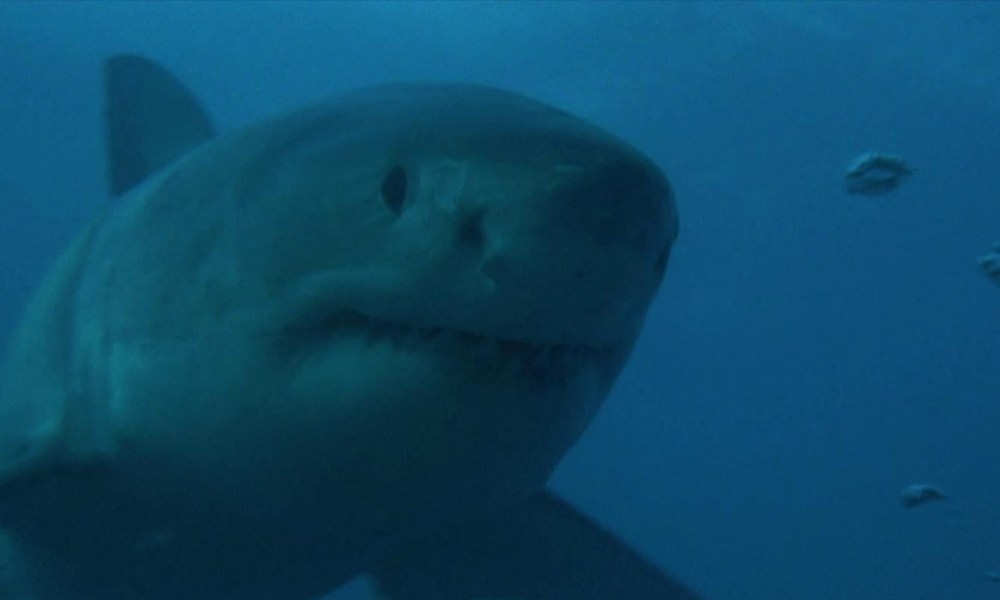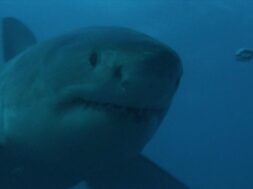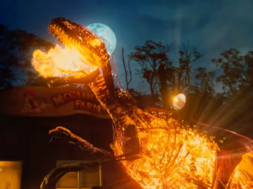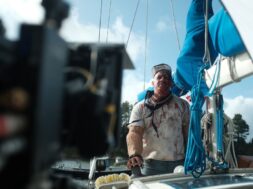
Before the 1975 masterpiece Jaws made us all afraid to go in the water, another film presented equally terrifying footage of real underwater nightmares. Directed by Peter Gimbel, the 1971 documentary Blue Water, White Death follows a group of aquatic photographers and adventurers determined to capture the first underwater footage of Carcharodon carcharias, the mythic apex predator commonly called the great white shark. While not a horror movie per se, the film presents breathtaking footage of massive sharks shot from within cages designed specifically for the expedition. It also includes shocking acts of animal cruelty and a dated understanding of marine wildlife. Premiering three years before publication of Peter Benchley’s best-selling novel Jaws, this unprecedented documentary formally introduced the world to the great white shark and likely planted seeds that would go on to change cinematic history as we know it.
Filmed in 1969, Gimbel and his crew departed from Durban, South Africa for a five-month expedition through the Indian Ocean in search of sharks they describe as “the most dangerous predator still living in the world.” Heir to the Gimbels department store fortune, Peter Gimbel was then known to US audiences as the first to dive and photograph wreckage of the SS Andrea Doria. Joining him on the voyage was producer Stan Waterman as well as Australian spearfishers and divers Valerie and Ron Taylor. (Steven Spielberg would later call on this husband and wife team to film the underwater sequences involving real sharks for his horror blockbuster Jaws.) All four divers serve as photographers and videographers during the shoot along with additional members of the large crew. They set off on the Terrier VIII, a 150-foot steamship along with a full camera crew, still photographers, technical coordinators, production assistants, and an adorable little dog named Billie. Tom Chapin, brother of the beloved folk singer Harry Chapin, even tags along to provide music for the expedition. Filming in a travelog format, Blue Water, White Death follows the cast and crew from location to location in search of man-eating sharks and the thrill of adventure.
Gimbel’s film begins with blood in the water. The titular blue expanse is suddenly filled with bright red liquid billowing through the ocean depths as shadowy images of sharks emerge from all directions. A title card proclaims the official stats of the great white species followed by salacious accounts of shark attacks in which two men were “swallowed whole” and “bit in two” by the fearsome predators. Despite introducing these animal stars by describing their power to kill, the documentary is not intentionally horrific. A distinct 70s vibe permeates every scene with gorgeous oceanscapes and dreamy folk music playing over transitional montages. Chapin frequently sits on the dock strumming and singing while the team reflects on their progress or prepares to dive. Several sequences display the natural beauty of each locale from intricate underwater reefs in the Mozambique Channel, local wildlife in South Australia, and gorgeous sunsets over the Indian Ocean.
While the film itself is not trying to frighten, several segments prove to be quite horrific. The crew first attempts to capture footage of the great white shark by following a whaling ship and using their resulting kills as bait. What follows is a nauseating sequence in which whalers shoot two sperm whales with harpoons and prepare their bleeding corpses to tow into shore. We see footage of this carnage up close, including one of the poor creatures spouting blood into the air after a harpoon punctures its lungs. Back on land, we watch as a steam engine carts the bodies along the beach to a whaling station where they are skinned and dismembered. It’s an incredibly upsetting scene on par with the turtle dissection in Ruggero Deodato’s 1980 film Cannibal Holocaust and reeks of dated ideas about consumption and human dominance over the natural world. Several divers express horror at this grisly treatment, however they are more than willing to use this whaling ship to attract their aquatic targets. Subsequent dives take place near a whale carcass left overnight, likely purchased by the wealthy adventurer to facilitate their after-hours shoot.
Heavily featured in the film is a relatively new type of underwater technology: shark-proof cages. Famed oceanographer Jacques Cousteau is credited with inventing these protective containers in which divers can safely observe dangerous marine wildlife up close. However, in preparation for this expedition, Gimbel developed his own type of aluminum cage which also functions as a sort of underwater elevator. Fully controllable from within the cage, these devices allow the occupants to rise and descend in the water as needed to capture footage of the surrounding ocean life. Unfortunately this requires laying a series of underwater cables to serve as base support. While attempting to install these cages near a shipwreck off the coast of Batticaloa, Sri Lanka Gimbel develops a dangerous case of decompression sickness (a.k.a. the bends) after diving more than 170 feet to the ocean floor. He eventually emerges safely, but only after a long and arduous trip to the surface in which he’s forced to remain at a series of decreasing depths while waiting for his body to naturally adjust to the underwater pressure.
Gimbel and his team spend the majority of the film searching for the creature they refer to as “whitey.” However, they manage to record spectacular footage of other shark species along the way. Diving near the whaler, they film a massive feeding frenzy of dusky, blue, and oceanic whitetip sharks. Hoping to capitalize on nighttime feeding patterns, they descend in the cages at 2:00 am filming the ghostly creatures in dark and dangerous waters. In a particularly frightening moment, a power short abruptly cuts all the lights in the cages, reducing visibility to nearly zero. The on-deck crew shines flashlights on the water searching for the cage openings and finally spots the terrified divers rising to the surface. Reflecting on the incident, Gimbel describes finding themselves in the pitch black water surrounded by hundreds of hungry sharks. However, this incident pales in comparison to the team’s adventures filming outside their protective barriers.
After observing the behavior of the sharks they’ve managed to locate, Gimbel convinces the crew to venture out of the cages while diving in infested waters. Armed only with fists and bang sticks, they swim along with the sharks feeding on a whale carcass buoyed on the water’s surface. The massive fish continually bump the divers and the cameras, creating the feeling that we are submerged in the icy water as well. This footage plays out silently, accompanied only by vague aquatic sounds, mimicking the aural deprivation of the underwater experience. At one moment we, along with the divers, are distracted by a large shark digging into the whale’s side when another appears out of nowhere to bump the camera. It’s a real life jump scare that puts most studio horror films to shame. Unfortunately this scene also includes a dark moment of animal cruelty. Hoping to repel a nearby shark, one of the divers uses a bang stick to strike the fish on its head, causing what appears to be a seizure. The camera follows the poor animal as it spins off to its likely demise in the inky blue depths.
After months with no great white sightings, Gimbel and crew deviate from their planned course and travel to the aptly named Dangerous Reef in South Australia. Ron has assured them that whites are frequently spotted here and the crew conduct an ominous interview before entering the water. Australian diver Rodney Fox, at the time one of the only known survivors of a great white attack, describes his ordeal in gruesome detail. His hair-raising story is intercut with grisly photos of the bites on his hand, defensive wounds against the shark’s massive jaws. Recounting his escape, Fox describes one nightmarish moment after breaking free and swimming to the surface. Surrounded by clouds of his own blood, he remembers looking down to see a massive conical head gliding up towards him through the water. This terrifying image feels eerily similar to the cover art of Peter Benchley’s novel, Jaws, and the now iconic poster art for Spielberg’s film adaptation.
Finally spotting the massive predators off the Australian coastline, Gimbel and team hurry to dive into the water. Using dissected farm animals to lure the carnivorous fish closer, they film 12-14 foot sharks circling and investigating the cages and boats. One magnificent predator first glides into view while swallowing a large piece of meat before directly biting the top rim of the cage. At one point, a shark severs the cable connecting Stan’s cage to the boat and he floats untethered in the water until help can arrive. As the divers slowly acclimate to their surroundings, they become more brave, not only reaching out to touch the animals as they pass, but emerging from the cages in hopes of getting footage not marred by the aluminum bars.
Near the end of the shoot, still photographer Peter Lake experiences a near-fatal moment in the cage. Using a now controversial technique known as shark baiting, the crew has tied large pieces of meat to the bars in hopes of attracting the animal’s attention. With the bait in its mouth, one massive shark tosses the cage around, bashing and biting until the bars are bent and the structure nearly destroyed. Lake scrambles to cut the line attaching the bait and the shark swims off with its prize, but the horrific scene perfectly demonstrates the fish’s awesome power. This mangled cage and harrowing incident reportedly inspired Benchley to write the heartbreaking death scene of marine biologist Matt Hooper, the youngest crew member of the ill-fated Orca.
After emerging safely from the dangerous waters, Gimbel and his team celebrate capturing the first underwater footage of great white sharks. Their months-long voyage has been a success by their standards, but it will forever alter the way we view these powerful animals. Combined with Spielberg’s Jaws, their breathtaking footage would ignite a world-wide obsession with the legendary species. Not only did audiences fear going into the water, but many saw it as their duty to rid the seas of these so-called maneaters. The documentary Sharksploitation details the devastating effects this call for aquatic safety has had on the world-wide shark population and the irreparable damage their extinction would pose to the oceanic ecosystem. The filmmakers and divers consider none of this while making the documentary and viewed through a modern lens, their interactions with many different animals could be described as exploitative and cruel. However, most of the documentary’s divers have gone on to advocate for protection and preservation of underwater habitats and along with Benchley himself, have become prominent names in the world of marine conservation.
Though it has been essentially forgotten by mainstream audiences, Blue Water, White Death sparked a turning point not only in cinema, but humanity’s understanding of the natural world. Gimbel and his team provide essential evidence for studying these majestic fish as well as terrifying footage of their deadly power. However, they emerge from their various dives with a greater respect for the animals. They are not scientists, but thrill-seekers, hoping to make history by capturing on film what Ron describes as “the ultimate” natural challenge. Upon diving with the sharks, they begin to see them not as monsters, but as autonomous beings simply trying to survive in their natural habitats. The divers of Blue Water, White Death may emerge with a more nuanced understanding of these apex predators, but it would take the rest of the world much longer to catch up.













